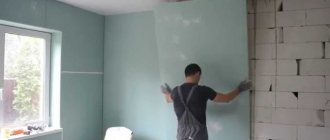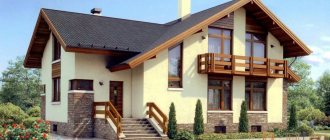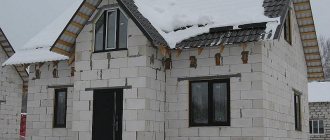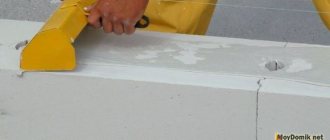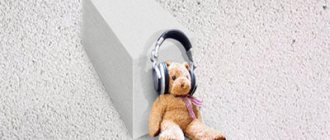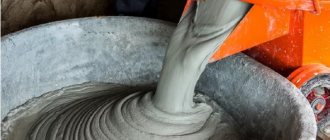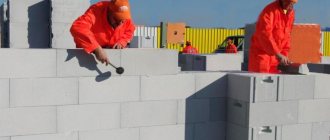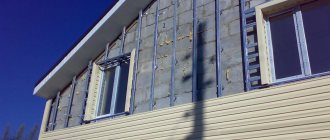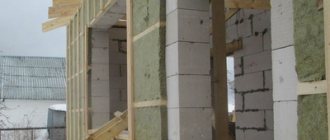Finishing: work process
Aerated concrete, although it has a concrete base, is a very porous material. The size of the porous cell is about 1 mm. Thanks to this, in a house built from such building material, a completely healthy “breathing” microclimate is created - almost the same as in a house made of wooden beams.
Aerated concrete has high vapor permeability, which means that, like wood, it is able to absorb and accumulate moisture. Therefore, the interior decoration of walls made of aerated concrete blocks should take this feature into account.
Let's consider how to choose the right materials, what methods and technologies to use, and what work needs to be done based on this.
Requirements for interior decoration
Finished room with finishing
When choosing a material for wall cladding from aerated block, you need to remember its high hygroscopicity.
Therefore, two problems arise simultaneously:
- Increase the comfort level of staying indoors. To do this, you need to ensure that there is no increase in humidity in the room. This can be ensured by a vapor-permeable finish and ventilation system.
- Reliably protect aerated block walls from moisture accumulation. Increased humidity inside the house will lead to the accumulation of moisture in aerated concrete and its rapid destruction. In this case, vapor-tight materials are used.
External wall insulation in section
The interior decoration of walls built from aerated block, no matter what material option is chosen, must comply with building codes.
If it is a vapor-permeable cladding, then it should not lead to the slightest retention of liquid in the aerated concrete, and if it is vapor-tight, it should not lead to the accumulation of dampness under a layer of finishing material on the wall surface. These problems can be solved by the correct choice of materials and their high-quality installation.
Cladding option
Comparison of the properties of vapor-permeable and vapor-tight finishes:
| Vapor permeable | Vapor-tight |
| Many professional builders choose this option. However, extremely strict requirements are imposed on the choice of material. It must have a high degree of vapor permeability. These are, first of all, materials such as:
Vapor-permeable properties prevent moisture from accumulating in the aerated concrete wall if condensation forms. This significantly extends its strength properties and durability of the entire structure. Vapor permeable is suitable for residential premises with normal humidity levels, in which it is necessary to maintain a healthy microclimate. | The vapor-tight finish allows for a greater variety of materials to be used. The main thing is that during operation the strength of the cladding and its vapor-tight properties are maintained.
Vapor-tight cladding is used in residential premises with high atmospheric humidity, for example, in the kitchen, bathroom, sauna, swimming pool, toilet, as well as for the interior decoration of non-residential warehouse or industrial premises. |
Attention! In general, the vapor permeability of the interior finish depends on the exterior version. If the facade, for example, is faced with brick without a ventilation gap, or with ceramic tiles, then the inside must have a vapor-tight finish, since there will be nowhere for steam to escape.
Cement plaster applied from the inside
What types of finishing of aerated block walls are there?
The most popular options:
- Creation of frame-hinged finishing with plasterboard or plastic/wood panels.
- Plastering.
- Block masonry (decorative brick, tile, artificial stone).
- Final putty.
- Painting/wallpapering.
Ceramic tile cladding
Recommendations for purchasing finishing materials
In order for the interior decoration of aerated concrete walls to be beautiful and aesthetic, high-quality and durable, it is necessary to choose the right finishing materials. It is quite easy to decide on the type of finish - the choice is huge, each type of finishing coating has its own advantages and disadvantages, which need to be studied first.
The main task is to find materials that will ideally interact with aerated concrete, improving and preserving the advantages of the material and minimizing the impact of its disadvantages on the comfort in operation of the building. You should not save on materials, since the result will depend on their quality.
Even if the optimal type of finishing is selected and all work is performed correctly, due to the low quality of materials, all efforts can be reduced to zero - the finishing will not last long and will not perform its functions.
It is better to purchase materials only from trusted suppliers who have all the documents and provide a guarantee for the product. All goods must exactly correspond to the task, meet the necessary requirements and have certain characteristics. Experts also recommend that when choosing several items, give preference to one manufacturer in order to be absolutely sure that the components of the products will not react and will not lead to surprises.
The most popular methods of interior finishing
Progress of finishing work
Let's consider the most popular finishing methods, their features, characteristics, performance, advantages, disadvantages and scope of application.
| Type of finish | Features/Specifications | Scope/advantages/disadvantages |
| Drywall
| Installation of drywall is carried out on a pre-mounted wooden, plastic or metal frame and has the following features:
There are at least three types of drywall:
As an option for finishing a gas-block wall, you can use plastic or wooden panels. Their installation is carried out according to the same rules. | Advantages:
Flaws:
Wooden and plastic panels are best suited for rooms with a high degree of air humidity. These can be kitchen premises, baths, bathrooms, swimming pools. Depending on the type, drywall is used in all types of premises. |
| Plaster
| The plastering process is necessarily preceded by the application of a waterproofing primer to the surface. In the future, the plastering process consists of the following stages:
If the plaster is vapor-permeable, the finishing material should have the same property. As a material for plaster, it is best to use special dry mixtures with high adhesive properties. Instructions with photos (pictures) on how to properly dilute the mixture and use it are usually included with the package. | The basis of plaster mixtures is cement or gypsum/lime as a binding component.
However, to prevent aerated concrete from absorbing moisture, it can be plastered only where the level of atmospheric humidity is at an acceptable level. Advantages of plastering:
Flaws:
|
| Block decorative masonry (tiles, brick, stone)
| Exterior finishing is often done in the form of decorative brick/stone/tile masonry. However, recently this method has begun to be used for interior cladding work. The only difference is the choice of material. For interior decoration, it is preferable to use vapor-permeable materials:
Naturally, the use of products for interior decorative block masonry from such materials is aimed at maintaining a healthy microclimate in the room. If the main task is to create maximum waterproofing, then it is better to use the same materials that are used for external cladding.
Today, finishing is done using so-called artificial stone. It can be based on a variety of components, but most often gypsum, lime and sand of various modifications. In general, the technology of internal block masonry is similar to the plastering process: preliminary preparation and priming are also required. | Decorative block masonry is used in the interior decoration of premises for various purposes - from residential/office to industrial and warehouse. For bathrooms, kitchens, toilets, swimming pools, saunas and baths, it is better to use tiles or blocks made of waterproof materials. Advantage:
Flaws:
|
| Final putty
| Finishing putty, as one of the final finishing options and as preparation before painting or gluing wallpaper. The material used is a special industrially produced gypsum-based finishing putty. Paint and wallpaper applied to the finishing coating must be made exclusively from vapor-permeable materials. Paints must have a silicate or silicone base, and wallpaper must have a paper base. | Used for leveling walls. The putty material is vapor-permeable, so it can be used in rooms with normal air humidity. The putty has the following advantages:
Flaws:
|
| Painting and wallpapering.
| Painting and applying wallpaper not only has a decorative function, but also a way to create a vapor barrier. Wallpaper, like paint, can have both vapor-permeable and vapor-proof properties. Before applying wallpaper or paint, the surface must be prepared:
Wallpaper can be:
All dyes are divided into waterproof and vapor-permeable. Waterproof ones are mainly acrylic, and vapor permeable ones are silicate or mineral. | Depending on the type of room, its purpose, ventilation system and humidity level, a waterproof or, conversely, vapor-permeable base of paints and wallpapers is selected. Advantages:
Flaws:
|
Drywall installation
Features of the interior design of walls made of aerated blocks
Figure 1. Preparing the walls
The interior of the room is one of the most important stages in the renovation, since it is always in the field of view of the residents, and the mood and well-being often depend on it. Before you begin interior decoration of a house made of aerated concrete , you should understand what the features and advantages of this material are.
Aerated concrete is actively used for the construction of buildings due to the presence of the following undeniable advantages:
- frost resistance;
- soundproofing;
- wear resistance;
- fire resistance;
- light weight;
- resistance to mold and mildew;
- long service life;
- creating a microclimate inside the house;
- prevents heat loss.
Important. The safety of the building directly depends on the materials used, so it is very important to choose them correctly.
The main thing you need to know when choosing the type of finish is that aerated concrete has increased breathability. If the inner walls are not finished with finishing material, condensation may appear after the penetration of warm air and subsequent cooling.
In other words, the thermal insulation of the house will deteriorate, and the gas blocks themselves will become damp, which will not have the best effect on the strength of the building. Therefore, the main task when finishing interior walls is to reduce air permeability. Various materials are perfect for these purposes: panels, wallpaper, etc.
Criteria for choosing a finishing method
Rough finish
When choosing a method of interior finishing of a gas-construction structure for a particular room, it is necessary to proceed primarily from its purpose and climatic parameters, as well as the possibility of changing them, budget and personal preferences or design ideas.
For those who are just starting to master this difficult skill, the video in this article shows where to start, how to choose materials and make the cladding with your own hands.
DIY plastering
A private house
Finishing an aerated concrete house inside
In your own house made of gas blocks, there are at least three types of premises:
- With a normal level of humidity (halls, bedrooms, living rooms, children's rooms, hallways). For finishing, it is better to use ordinary drywall, wood panels, paper wallpaper, water-permeable paint and vapor-permeable plaster or decorative blocks of gypsum, sand and lime.
- With a high level of humidity (kitchens, bathrooms, saunas, swimming pool, door area facing the street). It is better to use waterproof drywall, plastic panels and tiles.
- For household purposes, in which the humidity level may fluctuate (storerooms, plinths, boiler rooms). Ideally, cement-sand plaster should be used here; fire-resistant materials are suitable for combustion rooms.
Internal finishing of aerated concrete house
Office premises, public institutions
Priming office walls
The decoration of the interior walls of public premises should be based on those types of materials that ensure maximum durability of the building structure and, naturally, meet the design ideas in interior design.
It is better to line rooms located far from entrances/exits with vapor-permeable materials, while those located nearby and in contact with the street atmosphere should be lined with waterproof materials.
Office decoration
Rough work
First you need to apply plaster. To do this, the ceiling needs to be prepared, dirt and obvious unevenness must be removed. After this, when the plaster has dried, you can move on to working with putty. But such processes are necessary if the ceiling is to be painted or wallpapered.
For example, when using suspended or tension structures, careful preparation of the rough ceiling is not required. For suspended ceilings, you can use eurolining, plastic panels, plasterboard, special boards or slats. The important thing is that this solution makes it possible to also install insulation, which means improved thermal insulation of the room will be provided. Mineral wool, polystyrene foam and other analogues can be used as insulation.
Sip panels
If the house is made of vulture panels, the ceiling cladding, in fact, can be anything. Here you need to choose according to personal preferences and budget. An important advantage of this material is that, for example, finishing material can be fixed to OSB (top layer) using only self-tapping screws, without the need for dowels. Therefore, it is convenient to directly fasten drywall, panels, glue slabs and other materials.
But in this case it is more difficult to work with “wet” processes. Therefore, it is better to choose a solution that will allow you to fix the ceiling immediately, without the need for additional manipulations. For example, using the same wooden paneling.
How and with what to finish aerated concrete inside and outside
A building made of aerated concrete can stand without external finishing without any damage to the integrity of the blocks (we are talking about autoclaved aerated silicate). But, over time, dust settles on the surface of the blocks, and the previously white outer surface becomes an untidy gray color with streaks. So it doesn’t matter, sooner or later, but the question arises about the cladding or finishing of aerated concrete on the outside. Inside, the finishing of aerated concrete is done almost immediately after construction: the blocks do not look very attractive in the interior.
This is what aerated concrete looks like without finishing after a few years
Since aerated concrete has very high vapor permeability, there are certain nuances when carrying out finishing work. The fact is that almost all materials conduct vapors worse than gas silicate. This causes difficulties, since in order to ensure normal removal of water vapor from the room, the vapor permeability of the walls - from the room - to the outside must increase. Only special plaster mixtures for foam concrete meet this requirement. But subject to certain rules, the finishing can be anything.
